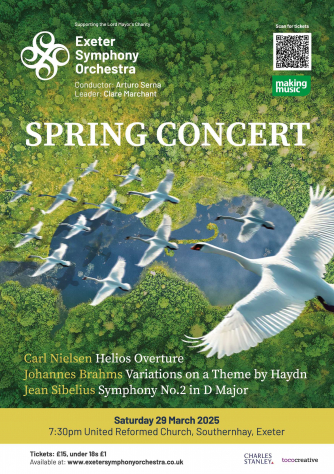Details
Southernhay United Reformed Church
Dix's Field
Exeter
Devon
EX1 1QA
England
Programme
Carl Nielsen – Helios Overture, Op.17
Johannes Brahms – Variations on a Theme by Haydn 'St. Anthony Variations', Op.56a (orchestra)
~ Interval ~
Jean Sibelius – Symphony no.2 in D major, Op.43
Performers
Arturo Serna – Conductor
Exeter Symphony Orchestra
Programme Note
Carl Nielsen (1865-1931) is widely recognised as Denmark’s greatest composer. From humble beginnings and the seventh of twelve children, his musical potential evolved steadily – from playing a tiny violin aged six, via service as army bugler and alto trombonist, to student of violin and composition in Copenhagen – his compositions gained recognition while a 2nd violinist in the Royal Danish Orchestra. His output included six highly-regarded symphonies, violin, flute and clarinet concerti, operas and songs, but the Helios Overture Op 17 we will play is among the most frequently performed. Inspired by a stay in Athens – in fact, a working holiday with his sculptress wife – this showpiece for orchestra, premiered in 1903, wonderfully evokes the rising and setting of the sun over the Aegean Sea.
A chance encounter with a wind ensemble arrangement of a work attributed to Joseph Haydn inspired Johannes Brahms(1833-1897) to write his Variations on a Theme by Haydn Op 56a. Also known as the St Anthony Variations, the now familiar piece – based on the eponymous chorale and comprised of a theme, eight variations and finale – displays a mastery of counterpoint rarely encountered in music of the Romantic period. In the final, magnificent restatement of the tune, Brahms – a generally austere composer – even permits himself the use of a triangle! This inventive and glorious piece was well-received when first performed by the Vienna Philharmonic Orchestra in 1873.
Buoyed by the success of his tone poem Finlandia at its premiere in 1900, Jean Sibelius (1865-1957) accepted an influential benefactor’s offer to spend some time in Italy where, he was advised, “one learns cantabile, balance and harmony…in a country where everything is beautiful, even the ugly”. Accordingly, while ensconced in his mountain villa near Rapallo, the composer was inspired to pen his beautiful Symphony No 2 in D major Op 43. When premiered in Helsinki in 1902 the first three performances were sell-outs, so there can be, perhaps, no greater endorsement than that of this masterpiece of orchestration which has even been favourably compared with the symphonies of Beethoven.

 Your events at Classical Events
Your events at Classical Events

